I know, I know, I listen to too many USA-based tech podcasts. And they always manage to raise my blood pressure. (Come to think of it, so do some UK-based tech podcasts, with their lack of actual knowledge of what they're spouting on about.... but I digress....)
In this case, the reviewer was talking about one of the latest huge-screened devices (Droid X or Evo 4G, probably) and, as I remember, made the comment "Battery life is normal for a modern smartphone and about what you'd expect. Use it moderately heavily and you'll be dead by 3pm. Look after your use more carefully and it'll last through the day."
Hang on, hang on, let's take a step back. Moderate use sees the smartphone dead by mid-afternoon? And that's considered normal? You'll remember I railed against an earlier US podcast quote in "How long SHOULD a smartphone battery last?" and I have to leap in again - I just can't help myself!
Again I make the contention that I shouldn't have to worry about my smartphone's battery letting me down during the day - ever. As long as I charged it the previous night, I expect it to last through the night, whatever I choose to do with the phone during the day*. And, as I often forget to put my smartphone on charge, I expect that even then it'll get me through the next day as well, with a little nursing. This sort of expectation has been met by most Symbian-based smartphones I've tried in the last ten years, with the possible exceptions of the N95, N96 and N97 mini, all of which were either underpowered in terms of milliAmp hours or too buggily implemented.
* Obviously, excluding silly use cases like using it for a two hour phone call or shooting a one hour video or watching two feature films...
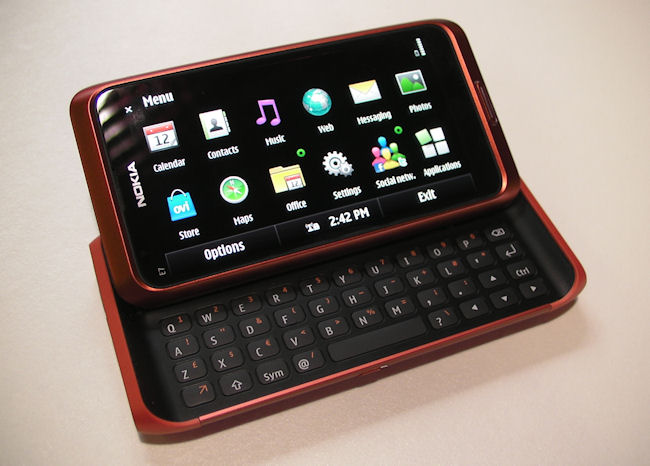
Having a smartphone 'die' by 3pm if I don't take care to manage its power is just ridiculous, I contend. Even more so for the new breed of smartphones with unibody/sealed form factors, where you can't just swap in another battery. In the editorial linked to above, I suggested a number of ways (both obvious and not so obvious) for manufacturers to improve battery life:
- Fit larger batteries. Yes, even at the expense of slightly thicker form factors. Not such a problem for Nokia phones running Symbian - but then we haven't seen the E7 yet...
- Make more of OLED power savings. This applies to all the latest Symbian^3 phones, a theme I'll return to below...
- Keep the screen size down. Again, I return to worrying about the E7!
- More radio intelligence needed (managing cellular data and other radio transmissions far better, with battery saving in mind)
- Keep clock speeds down but improve the efficiency of the OS and application code
All these are still valid, of course, plus I'd add another that has been implemented successfully on all the latest Nokia devices - that of using the ambient light sensor properly to vary the screen brightness and save power when used indoors or in the evening/night.
But, returning to the title for this feature, point 2 screams out at me now that I've used the Nokia N8 and C7 for a few weeks. Both (along with the C6-01 and E7, so that's the whole of Nokia's new Symbian range) have OLED screens, in which pixels that are black draw no power at all and pixels that are bright/white draw maximum power. A study has shown that the two extremes represent a factor of FIFTEEN in power drain. That's an immense difference. And one which Nokia's engineers understood when they ONLY put black themes into the devices, ones in which most pixels were black most of the time, helping eke out the resources of the (in the N8's case non-replaceable) 1200mAh batteries. The Nokia Messaging folks also got the 'message' (see what I did there?...) and also designed their next-gen email system to obey the rules and retain the system's theme, so usually black with black, etc.
But then the Ovi Store and Nokia Social Networking guys stuck their oars in. Now, Ovi Store can just about get away with running under its own 'white' theme - after all, a user's not going to spend more than an hour a week in the store client, surely. And remember that Web itself has to render the background colour of the sites it's asked to display - 99% of sites are essentially white and there's not much that can be done about this. But one of the core modules of Nokia's software platform for the new devices is 'Nokia Social Networking' and this has been implemented in the same way as the Ovi Store client, with a white background for all its views.
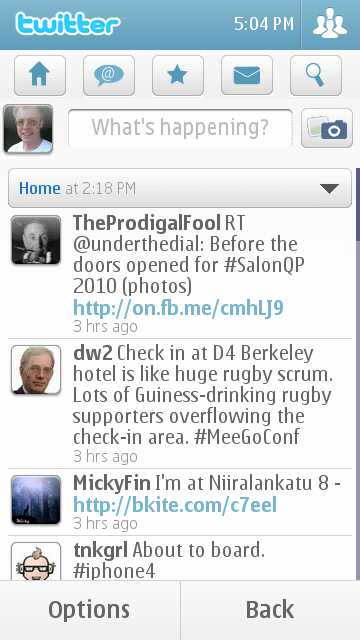
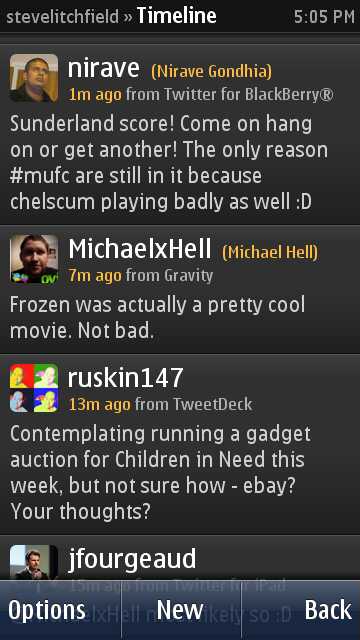
Nokia Social Networking (left), Gravity (right), with its 'dark' theme
Now, a user is, assuming they're happy with the Social Networking system (it's much better after the recent update), going to spend many hours a week in this application and it's absolutely crazy that most of the pixels in the OLED screens on the new phones are all lit up, all the time. I've pointed this out several times to contacts within Nokia but noone's indicated so far that anything's being done about it.
So I'm moaning about it here.
Referring you to the factor of fifteen mentioned above (for the extreme case of all white, all the time), in the real world, for a user who uses Social Networking heavily, it's entirely conceivable that the battery life of their new Nokia Symbian^3, OLED-screened smartphone could be as much as HALVED with all the pixel-lit wastage.
Or, to put it another way, Nokia could quite realistically DOUBLE the real world battery life of their new phones for some users by simply changing the theme used in ONE application. And if Nokia's designers have any remaining doubts, they should go off and try the third party Gravity, which has an 'alternative' dark theme and looks and works wonderfully in this guise. It's a relatively trivial change and could make a huge difference. No battery re-wiring, no fiddling with the OS kernel, no underclocking of the processor - just change the colours used by Social Networking. It's not rocket science.
With that rant out the way and with Nokia's product managers having hopefully been paying attention, I'd like to have a little fun....
Presenting my top 5 battery champions from the Symbian world from the last decade. Obviously, there are enormous changes in display size, specification and use case across the intervening ten years, but these five phones have, for me, symbolised maximum functionality without sacrificing maximum battery life. And, in most cases, each of these phones would run happily for not one, not two, but sometimes three days at a time, on a single charge, under 'normal' use.
- Nokia 6650
It's quite inexplicable why Nokia decided to put their hero BP-4L Li-Poly battery in a diminutive S60 3rd Edition 'RAZR-clone' clamshell, but anyone who likes a stylish smartphone and wants maximum battery life should be glad they did. The phone works very well as long as you're happy with more of a phone-focus than a smartphone one, and the music and clock-centric exterior display is fun to use. And, yes, this smartphone'll go a week on a single charge.
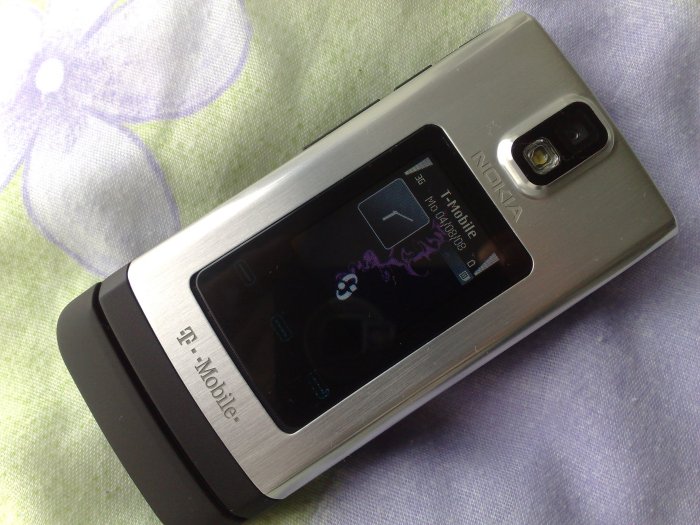
- Nokia 9500
Again, it's the BP-4L, but in one of its very earliest uses, in the second generation Communicator. Running Series 80 on top of Symbian, it was the flagship device for this interface. Despite a large 4.5" colour screen, its battery life, at least for 2004/2005 use cases, was two or three days, pretty amazing and this was my weapon of choice for well over a year.
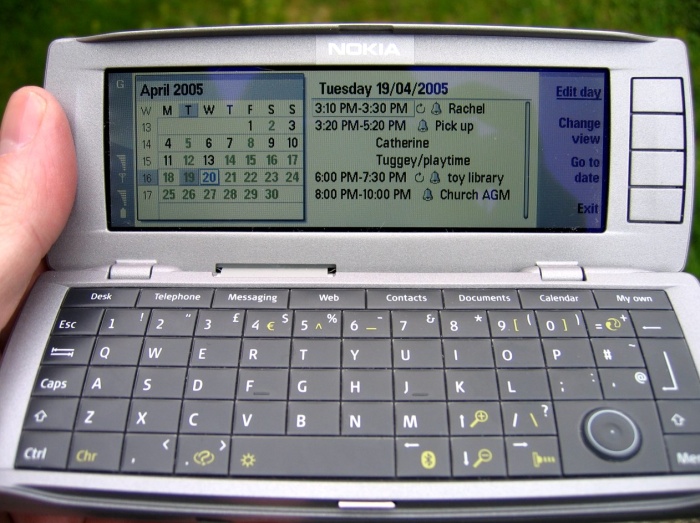
- Nokia E55
The thinnest, smallest device ever to sport the BP-4L (are you spotting a pattern yet?), I'd be confident of taking this into the wilds for a WEEK of 2G email and fairly moderate use - and not even bother taking a charger with me. If you can get past the 'Compact qwerty' keyboard (it IS possible to get to love it) then this is an amazing smartphone for battery life, and you can now get it at bargain prices on the second hand market (or win one here).

- Nokia E90
The third generation of Communicator and alternately loved and hated. Loved because of the robust hardware, large screen and battery life (cough - BP-4L) and hated because the marriage of 4" landscape screen and S60 3rd Edition wasn't a total success. Still great to own one of these though and I'm never selling mine. It's still the perfect journalist's conference smartphone.
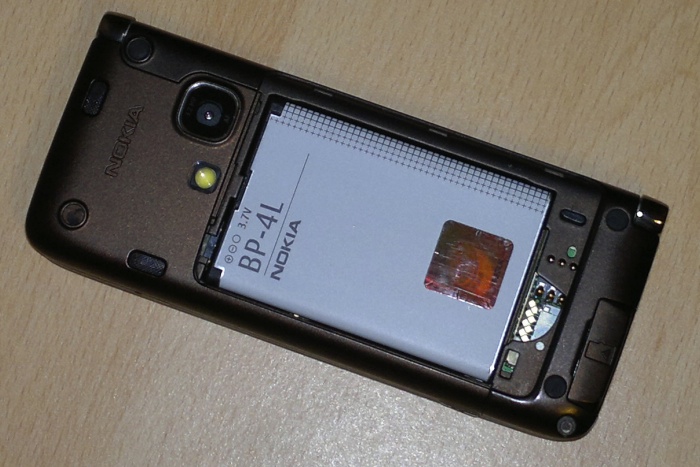
- Nokia E63
The 'budget' version of the classic E71, in some ways the E63 is better, with 3.5mm audio out, LED torch mode, virtually indestructible and can be found for less than £80 second hand, unlocked. And yes, it ALSO uses the BP-4L and, in my daughter's hands (you may remember I just said it was virtually indestructible!), regularly went a week and a half of light use on a single charge.

Comments welcome on my battery rant, on the need for a colour change to Nokia Social, or on my top 5!
Steve Litchfield, All About Symbian, 14 November 2010
